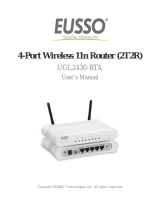1 Select the Wireless tab on the configuration menu
bar.
2 In the Network Name (SSID) box, type the
service set identifier using up to 32 alphanumeric
characters, as indicated in the converted configuration
text file.
When a client looks to connect wirelessly to the WR850, this
SSID will be the identifier by which it recognizes the
network.
The default is motorola plus the Wireless MAC Address,
which can be found on the product label.
In the Channel box, select the channel to use (in the
U.S., available channels are 1 through 11). You can
switch the channel if you experience poor wireless
performance due to interference.
4 Be sure all other parameters listed in the .txt file
you generated match the parameter fields on this screen.
5 Click Apply. When it is done, click Continue.
Review the changes and then go to another configura-
tion page by selecting another tab on the configuration
menu bar. If you are done configuring, see “Restarting
the WR850.”
To configure the security options which protect
information sharing over wireless connections:
When you upgrade, all security configuration settings are
replaced with version 6.x defaults. Refer to Table 1 for more
information about each configuration parameter on the
Security page.
Note: Refer to the text file you generated using the
conversion utility to make changes on this page.
1 Select the Security tab on the configuration menu
bar.
2 In the WPA-PSK box, select Enabled or
Disabled from the list. This engages or disengages Wi-
Fi Protected Access (WPA®) authentication using the
Pre-Shared Key (PSK) method.
3 In the WPA2-PSK box, select Enabled or Disabled
from the list. This engages or disengages Wi-Fi
Protected Access (WPA) version 2 authentication using
the Pre-Shared Key (PSK) method.
Notes: 1) The next option (step 4) is dimmed unless
WPA, WPA2, WPA-PSK or WPA2-PSK is Enabled. 2) For
optimum security, the same authentication and encryp-
tion methods (step 4) should be used for the WR850 and
all devices with which it will communicate. However,
multiple methods can be used. For example, WPA-PSK
and WPA2-PSK can be enabled concurrently to support
devices with mixed capabilities. Refer to
“Authentication Methods” in Section 3 in the user guide
for details.
4 In the WPA Encryption box, select an
encryption method:
TKIP – engages the Temporal key Integrity Protocol
AES – engages the Advanced Encryption Standard
TKIP + AES – supports a mix of devices using these
two encryption methods
Notes: 1) The next option (step 5) is dimmed unless
WPA, WPA2, WPA-PSK or WPA2-PSK is Enabled. 2)
Using at least 20 characters is strongly recommended for
the pass phrase. 3) As you enter the pass phrase, it does
not appear. After you apply the changes, you can select
the Show button to display the pass phrase in a small
dialog box.
5 In the WPA Pass Phrase box, type a phrase between 8
and 63 alphanumeric characters or exactly 64 hexadeci-
mal digits (0-9, A-F).
6 Click Apply. When it is done, click Continue. Review
the changes and then go to another configuration page
by selecting another tab on the configuration menu bar.
If you are done configuring, see “Restarting the WR850.”
How to Set Parental Controls
As indicated in the summary of changes in this document,
parental controls can be set on the Filters configuration
page. See Section 3 of the updated “WR850 Wireless
Broadband Routers User Guide.” Refer to “Filters Page
Examples – Establishing Parental Controls on Internet Use”
for reconfiguring parental controls with the 6.x WR850
firmware.
Restarting the WR850
If you are done configuring and applying the changes, you
are ready to restart the unit:
1 Print out each configuration page to retain a hard
copy of the new settings.
2 When you are finished printing, select the Basic
tab and click Restart.
3 After the WR850 reboots, click Continue. The Basic
page reappears.
Configuration Mapping
The following table provides a way for users to find
configuration parameters renamed from earlier versions of
the WR850 and locate them in version 6.x.















